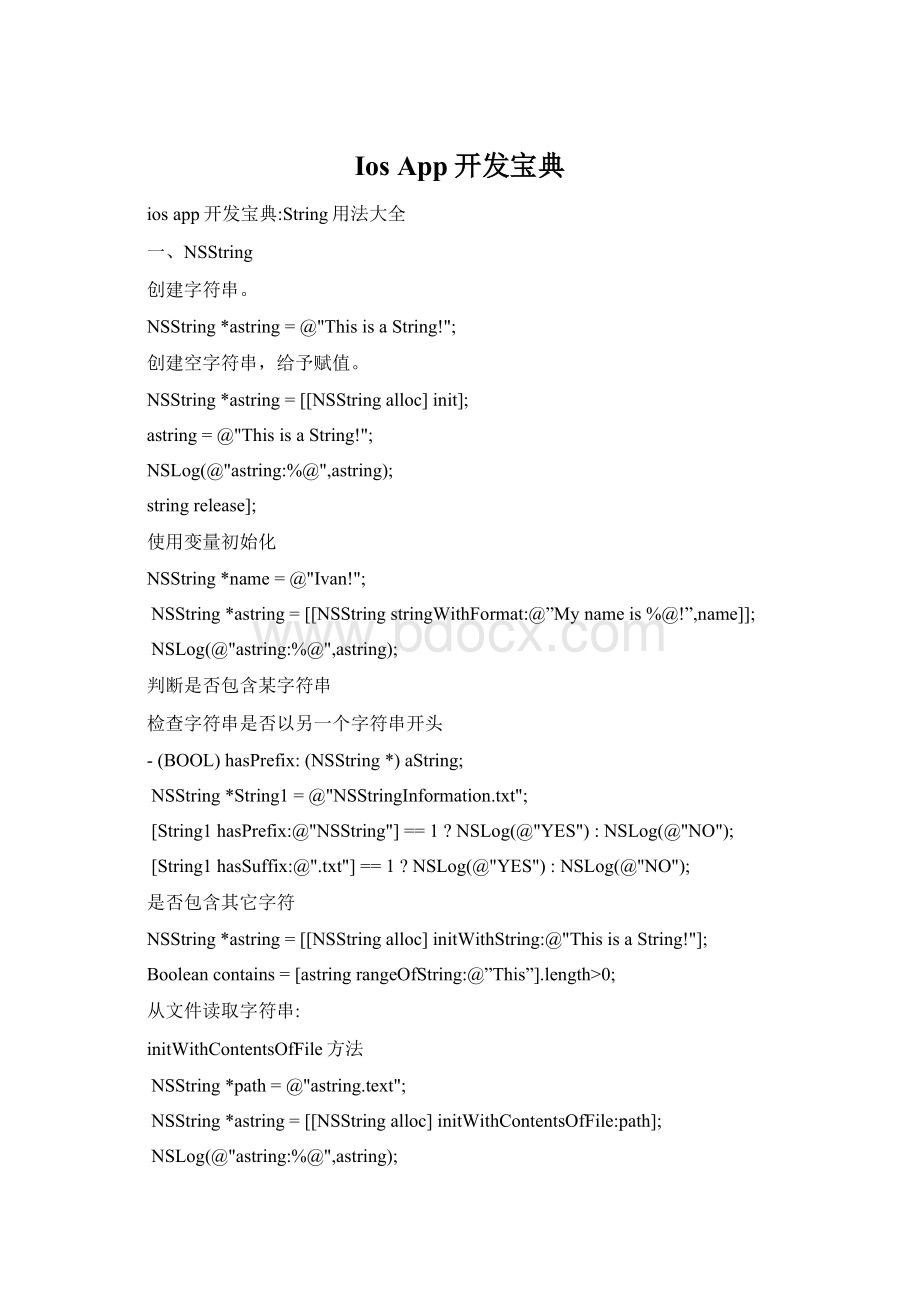Ios App开发宝典.docx
《Ios App开发宝典.docx》由会员分享,可在线阅读,更多相关《Ios App开发宝典.docx(13页珍藏版)》请在冰豆网上搜索。

IosApp开发宝典
iosapp开发宝典:
String用法大全
一、NSString
创建字符串。
NSString*astring=@"ThisisaString!
";
创建空字符串,给予赋值。
NSString*astring=[[NSStringalloc]init];
astring=@"ThisisaString!
";
NSLog(@"astring:
%@",astring);
stringrelease];
使用变量初始化
NSString*name=@"Ivan!
";
NSString*astring=[[NSStringstringWithFormat:
@”Mynameis%@!
”,name]];
NSLog(@"astring:
%@",astring);
判断是否包含某字符串
检查字符串是否以另一个字符串开头
-(BOOL)hasPrefix:
(NSString*)aString;
NSString*String1=@"NSStringInformation.txt";
[String1hasPrefix:
@"NSString"]==1?
NSLog(@"YES"):
NSLog(@"NO");
[String1hasSuffix:
@".txt"]==1?
NSLog(@"YES"):
NSLog(@"NO");
是否包含其它字符
NSString*astring=[[NSStringalloc]initWithString:
@"ThisisaString!
"];
Booleancontains=[astringrangeOfString:
@”This”].length>0;
从文件读取字符串:
initWithContentsOfFile方法
NSString*path=@"astring.text";
NSString*astring=[[NSStringalloc]initWithContentsOfFile:
path];
NSLog(@"astring:
%@",astring);
[astringrelease];
写字符串到文件:
writeToFile方法
NSString*astring=[[NSStringalloc]initWithString:
@"ThisisaString!
"];
NSLog(@"astring:
%@",astring);
NSString*path=@"astring.text";
[astringwriteToFile:
pathatomically:
YES];
[astringrelease];
比较两个字符串
isEqualToString方法
NSString*astring01=@"ThisisaString!
";
NSString*astring02=@"ThisisaString!
";
BOOLresult=[astring01isEqualToString:
astring02];
NSLog(@"result:
%d",result);
compare方法(comparer返回的三种值)
NSString*astring01=@"ThisisaString!
";
NSString*astring02=@"ThisisaString!
";
BOOLresult=[astring01compare:
astring02]==NSOrderedSame;
NSLog(@"result:
%d",result);
NSOrderedSame判断两者内容是否相同
NSString*astring01=@"ThisisaString!
";
NSString*astring02=@"thisisaString!
";
BOOLresult=[astring01compare:
astring02]==NSOrderedAscending;
NSLog(@"result:
%d",result);
不考虑大小写比较字符串1
NSString*astring01=@"thisisaString!
";
NSString*astring02=@"ThisisaString!
";
BOOLresult=[astring01caseInsensitiveCompare:
astring02]==NSOrderedSame;
NSLog(@"result:
%d",result);
改变字符串的大小写
NSString*string1=@"AString";
NSString*string2=@"String";
NSLog(@"string1:
%@",[string1uppercaseString]);//大写
NSLog(@"string2:
%@",[string2lowercaseString]);//小写
NSLog(@"string2:
%@",[string2capitalizedString]);//首字母大小
在串中搜索子串
NSString*string1=@"Thisisastring";
NSString*string2=@"string";
NSRangerange=[string1rangeOfString:
string2];
intlocation=range.location;
intleight=range.length;
NSString*astring=[[NSStringalloc]initWithString:
[NSStringstringWithFormat:
@"Location:
%i,Leight:
%i",location,leight]];
NSLog(@"astring:
%@",astring);
[astringrelease];
替换字符串
NSString*astring01=@"hello中国";
NSString*new=[astring01stringByReplacingOccurrencesOfString:
@”中国”withString:
@"北京"];
NSLog(new);
分割字符串成数组
NSString*s=@"abdef";
NSArray*arr=[scomponentsSeparatedByString:
@""];
NSLog(@"count=%d",[arrcount]);
字符串数组拼接成字符串
NSArray*pathArray=[NSArrayarrayWithObjects:
@"here",
@"be",@"dragons",nil];
NSLog(@"%@",[pathArraycomponentsJoinedByString:
@""]);
抽取子串
-substringToIndex:
从字符串的开头一直截取到指定的位置,但不包括该位置的字符
NSString*string1=@"Thisisastring";
NSString*string2=[string1substringToIndex:
3];
NSLog(@"string2:
%@",string2);
-substringFromIndex:
以指定位置开始(包括指定位置的字符),并包括之后的全部字符
NSString*string1=@"Thisisastring";
NSString*string2=[string1substringFromIndex:
3];
NSLog(@"string2:
%@",string2);
-substringWithRange:
//按照所给出的位置,长度,任意地从字符串中截取子串
NSString*string1=@"Thisisastring";
NSString*string2=[string1substringWithRange:
NSMakeRange(0,4)];
NSLog(@"string2:
%@",string2);
二、NSMutableString
给字符串分配容量
//stringWithCapacity:
NSMutableString*String;
String=[NSMutableStringstringWithCapacity:
40];
在已有字符串后面添加字符
//appendString:
andappendFormat:
NSMutableString*String1=[[NSMutableStringalloc]initWithString:
@"ThisisaNSMutableString"];
//[String1appendString:
@",Iwillbeaddingsomecharacter"];
[String1appendFormat:
[NSStringstringWithFormat:
@",Iwillbeaddingsomecharacter"]];
NSLog(@"String1:
%@",String1);
*/
在已有字符串中按照所给出范围和长度删除字符
//deleteCharactersInRange:
NSMutableString*String1=[[NSMutableStringalloc]initWithString:
@"ThisisaNSMutableString"];
[String1deleteCharactersInRange:
NSMakeRange(0,5)];
NSLog(@"String1:
%@",String1);
在已有字符串后面在所指定的位置中插入给出的字符串
//-insertString:
atIndex:
NSMutableString*String1=[[NSMutableStringalloc]initWithString:
@"ThisisaNSMutableString"];
[String1insertString:
@"Hi!
"atIndex:
0];
NSLog(@"String1:
%@",String1);
将已有的换成其它的字符串
//-setString:
NSMutableString*String1=[[NSMutableStringalloc]initWithString:
@"ThisisaNSMutableString"];
[String1setString:
@"HelloWord!
"];
NSLog(@"String1:
%@",String1);
按照所给出的范围,和字符串替换的原有的字符
//-setString:
NSMutableString*String1=[[NSMutableStringalloc]initWithString:
@"ThisisaNSMutableString"];
[String1replaceCharactersInRange:
NSMakeRange(0,4)withString:
@"That"];
NSLog(@"String1:
%@",String1);
三、NSArray
创建数组
NSArray*array=[[NSArrayalloc]initWithObjects:
@"One",@"Two",@"Three",@"Four",nil];
self.dataArray=array;
[arrayrelease];
//-(unsigned)Count;数组所包含对象个数;
NSLog(@"self.dataArraycound:
%d",[self.dataArraycount]);
//获取指定索引处的对象
NSLog(@"self.dataArraycound2:
%@",[self.dataArrayobjectAtIndex:
2]);
从一个数组拷贝数据到另一数组
//arrayWithArray:
//NSArray*array1=[[NSArrayalloc]init];
NSMutableArray*MutableArray=[[NSMutableArrayalloc]init];
NSArray*array=[NSArrayarrayWithObjects:
@"a",@"b",@"c",nil];
NSLog(@"array:
%@",array);
MutableArray=[NSMutableArrayarrayWithArray:
array];
NSLog(@"MutableArray:
%@",MutableArray);
array1=[NSArrayarrayWithArray:
array];
NSLog(@"array1:
%@",array1);
//Copy
//idobj;
NSMutableArray*newArray=[[NSMutableArrayalloc]init];
NSArray*oldArray=[NSArrayarrayWithObjects:
@"a",@"b",@"c",@"d",@"e",@"f",@"g",@"h",nil];
NSLog(@"oldArray:
%@",oldArray);
for(inti=0;i<[oldArraycount];i++)
{
obj=[[oldArrayobjectAtIndex:
i]copy];
[newArrayaddObject:
obj];
}
//
NSLog(@"newArray:
%@",newArray);
[newArrayrelease];
快速遍历数组
//NSMutableArray*newArray=[[NSMutableArrayalloc]init];
NSArray*oldArray=[NSArrayarrayWithObjects:
@"a",@"b",@"c",@"d",@"e",@"f",@"g",@"h",nil];
NSLog(@"oldArray:
%@",oldArray);
for(idobjinoldArray)
{
[newArrayaddObject:
obj];
}
//
NSLog(@"newArray:
%@",newArray);
[newArrayrelease];
Copyandsort
//NSMutableArray*newArray=[[NSMutableArrayalloc]init];
NSArray*oldArray=[NSArrayarrayWithObjects:
@"b",@"a",@"e",@"d",@"c",@"f",@"h",@"g",nil];
NSLog(@"oldArray:
%@",oldArray);
NSEnumerator*enumerator;
enumerator=[oldArrayobjectEnumerator];
idobj;
while(obj=[enumeratornextObject])
{
[newArrayaddObject:
obj];
}
[newArraysortUsingSelector:
@selector(compare:
)];
NSLog(@"newArray:
%@",newArray);
[newArrayrelease];
NSMutableArray
给数组分配容量
//NSArray*array;
array=[NSMutableArrayarrayWithCapacity:
20];
在数组末尾添加对象
//-(void)addObject:
(id)anObject;
//NSMutableArray*array=[NSMutableArrayarrayWithObjects:
@"One",@"Two",@"Three",nil];
[arrayaddObject:
@"Four"];
NSLog(@"array:
%@",array);
删除数组中指定索引处对象
//-(void)removeObjectAtIndex:
(unsigned)index;
//NSMutableArray*array=[NSMutableArrayarrayWithObjects:
@"One",@"Two",@"Three",nil];
[arrayremoveObjectAtIndex:
1];
NSLog(@"array:
%@",array);
数组枚举
从前向后
//NSMutableArray*array=[NSMutableArrayarrayWithObjects:
@"One",@"Two",@"Three",nil];
NSEnumerator*enumerator;
enumerator=[arrayobjectEnumerator];
idthingie;
while(thingie=[enumeratornextObject]){
NSLog(@"thingie:
%@",thingie);
}
从后向前
NSMutableArray*array=[NSMutableArrayarrayWithObjects:
@"One",@"Two",@"Three",nil];
NSEnumerator*enumerator;
enumerator=[arrayreverseObjectEnumerator];
idobject;
while(object=[enumeratornextObject]){
NSLog(@"object:
%@",object);
}
快速枚举
//NSMutableArray*array=[NSMutableArrayarrayWithObjects:
@"One",@"Two",@"Three",nil];
for(NSString*stringinarray)
{
NSLog(@"string:
%@",string);
}
NSDictionary
创建字典
//-(id)initWithObjectsAndKeys;
ctionary*dictionary=[[NSDictionaryalloc]initWithObjectsAndKeys:
@"One",@"1",@"Two",@"2",@"Three",@"3",nil];
NSString*string=[dictionaryobjectForKey:
@"One"];
NSLog(@"string:
%@",string);
NSLog(@"dictionary:
%@",dictionary);
[dictionaryrelease];
练习题:
将文本“成绩单.text”内容加载到内存中并按规定的格式输出出来
NSMutableDictionary
创建
NSMutableDictionary*dictionary=[NSMutableDictionarydictionary];
添加字典
[dictionarysetObject:
@"One"forKey:
@"1"];
[dictionarysetObject:
@"Two"forKey:
@"2"];
[dictionarysetObject:
@"Three"forKey:
@"3"];
[dictionarysetObject:
@"Four"forKey:
@"4"];
NSLog(@"dictionary:
%@",dictionary);
删除指定的字典
[dictionaryremoveObjectForKey:
@"3"];
NSLog(@"dictionary:
%@",dictionary);
NSValue(对任何对象进行包装)
将NSRect放入NSArray中
NSMutableArray*array=[[NSMutableArrayalloc]init];
NSValue*value;
CGRectrect=CGRectMake(0,0,320,480);
value=[NSValuevalueWithBytes:
&rectobjCType:
@encode(CGRect)];
[arrayaddObject:
value];
NSLog(@"array:
%@",array);
从Array中提取
value=[arrayobjectAtIndex:
0];
[valuegetValue:
&rect];
NSLog(@"value:
%@",value);
定义结构体并添加到NSArray里面
typedefstruct{
floatreal;
floatimaginary;
}ImaginaryNumber;
ImaginaryNumbermiNumber;
miNumber.real=1.1;
miNumber.imaginary=1.41;
NSValue*miValue=[NSValuevalue:
miNumber
withObjCType:
@encode(ImaginaryNumber)];//encodeusingthetypename
ImaginaryNumbermiNumber2;
[miValuegetValue:
&miNumber2];
四、宏定义#define讲解
NSNumber
+(NSNumber*)numberWithInt:
(int)value;
+(NSNumber*)numberWithDouble:
(double)value;
-(int)intVal